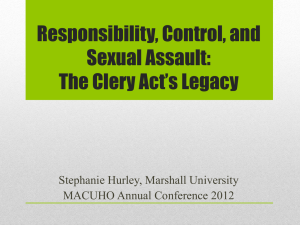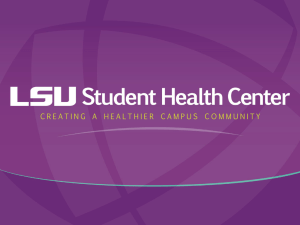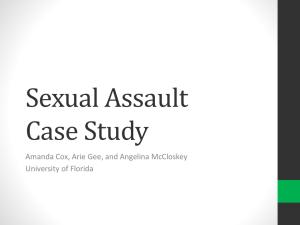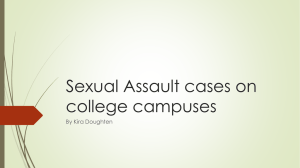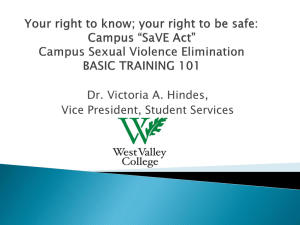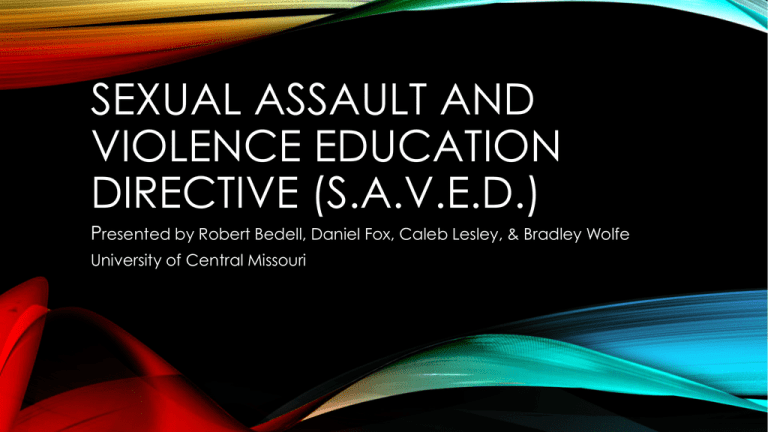
SEXUAL ASSAULT AND
VIOLENCE EDUCATION
DIRECTIVE (S.A.V.E.D.)
Presented by Robert Bedell, Daniel Fox, Caleb Lesley, & Bradley Wolfe
University of Central Missouri
MISSION STATEMENT
• To inform the campus population about sexual assault awareness and
educate students about preventative measures to protect the campus
population against sexual crimes
• Creating a fair and just campus community
• Committed to educating students on the facts in regards to the severity and
frequency of sexual crimes
• Establish a campus wide initiative for preventing sexual assault via
departmental collaboration throughout the university
• Develop a sense of community responsibility in regards to preventing sexual
misconduct
CREATING AND CLAIMING VALUE
• We will strive to make this campaign a main focal point on our campus
• Buy in is crucial from both internal and external stakeholders
• Reach out to alumni for financial support and for them to assist in supporting
out sexual misconduct initiatives
• Supply empirical data to create buy in from key stakeholders
• Develop buy in from the board of governors and president of the institution
BUDGETING
•
•
•
•
•
•
•
Fiduciary duty act in the best interest of the institution
Explore grant opportunities available from national organizations
Seek state and federal funding
Consult with Vice President for Student Affairs
Student programming fees
Contact alumni and supporters of the university to seek financial assistance
Fundraising
• Sexual crime awareness wristbands
• Jeopardy game show set up with trivia pertaining to facts about sexual crimes to
assist in eliminating myths on campus
• Do more with the resources we already have available
STUDENT DEVELOPMENT THEORY
• Kohlberg's stages of moral reasoning
• Stage 1= Heteronomous Morality- this stages signifies obeying by the rules just to
avoid punishment
• Stage 4= Social system morality- The individual views rules and procedures as
applying to all individuals within the society equally
• Stage 5= Human rights and Social Welfare Morality- The individual evaluates rules
and procedures in regards to how the rule/procedure promotes welfare and
protects rights and values
Evans, N.J., Forney, D.S., Guido F.M., Patton, L.D., &
Renn, K.A. (2010). Student development in college:
Theory, research, and practice (2nd ed.). San
Francisco, CA: Jossey-Bass.
APPLICATION OF LAW
• Tort Law/Liability- a tort, in common
law jurisdictions is a civil wrong
which unfairly causes someone else
to suffer loss or harm resulting in
legal liability for the person who
commits the tortious act
• FERPA will be applied to protect the
identities of those involved from the
campus community involved in any
sexual crimes
• Nero v. Kansas State University
• A female student was sexually
assaulted in a coed residence hall
by a fellow student living in the
residence hall
• The male had previously been
accused of raping another student
on campus
• The female claimed the university
had a special duty to protect her
• The university was found responsible
on the legal basis of foreseeability
COUNCIL FOR THE ADVANCEMENT OF
STANDARDS (CAS)
• Non-malfeasance – do no harm
• Create environments that are educational and supportive of the growth and
development of the whole person
• Interact in ways that promote positive outcomes
• Collaborate with others for the good of those whom we serve.
• Justice
• Actively promote human dignity and endorse equality and fairness for everyone
• Treat others with respect and fairness, preserving their dignity, honoring their
differences, and promoting their welfare
• Extend fundamental fairness to all persons
• Affiliation
• Create environments that promote connectivity
• Promote authenticity, mutual empathy, and engagement within human interactions
CONSENT DEFINED
• Consent is when someone agrees, gives permission or says yes to sexual activity with
someone else. It is always freely given and both people in a sexual situation must feel
that s/he is able to say “yes” or “no” at ANY point during sexual activity.
• At the heart of the idea of consent is the idea that every person, man or woman, has the
right to personal sovereignty – not to be acted upon by someone else in a sexual manner
unless he or she gives clear permission to do so.
• Consent to one form or sexual activity does not automatically imply consent to other
forms of sexual activity.
• Consent means you can’t make assumptions about what your partner does or does not
want. Absence of clear signals means that you CAN’T touch someone else, not that
you CAN.
Handeyside, A. and Wickliffe, S. (2009). Striving for Justice: A Toolkit for Judicial
Resolution Officers on College Campuses. Responding to Sexual Assault and Dating
and Domestic Violence.
CONSENT DEFINED
• Respect for another member of the community is an expectation that all members are expected
to uphold at all times, including in the context of sexual interaction. Respect means paying heed to
verbal and nonverbal cues, desires, boundaries, and behaviors of others.
• There are circumstances, as well, where even when consent is given, it is not valid. Consent would
be invalid when forced, threatened, intimidated, coerced, when given by a mentally or physically
incapacitated person, or when given by a minor.
• No means no, but nothing also means no. Silence and passivity do not equal permission.
• Consent can be withdrawn at any time.
• If you get a “no” and keep right on pressuring and continuing to interact sexually, you run the risk
that your behaviors are a coercive influence on the other party.
Handeyside, A. and Wickliffe, S. (2009). Striving for Justice: A Toolkit for Judicial
Resolution Officers on College Campuses. Responding to Sexual Assault and Dating
and Domestic Violence.
COERCION DEFINED
• Coercion is a tactic used by perpetrators to intimidate, trick or force someone to have sex with
him/her without physical force.
• Coercion is an issue of power and control.
• A perpetrator who uses coercive tactics knows that his or her victim neither wants nor enjoys this
sexual interaction.
• Assailants use many forms of coercion, threats, and manipulation to rape including alcohol and
drugs. Alcohol, Rohypnol, and other drugs are often used to incapacitate victims.
• Men who have committed sexual assault also frequently report getting their victims drunk as a way
of making it easier to talk or force him or her into having sex.
• Although the media has labeled drugs such as Rohypnol and GHB as the date-rape drugs of the
present, these are only two of the many drugs used to incapacitate a victim. Of the 22 substances
used in drug-facilitated rapes, alcohol is the most common.
Handeyside, A. and Wickliffe, S. (2009). Striving for Justice: A Toolkit for Judicial
Resolution Officers on College Campuses. Responding to Sexual Assault and Dating
and Domestic Violence.
PARTNERSHIPS
•
•
•
•
•
•
•
•
•
•
Counseling and Psychological Services
Campus Police/ Student Assistant Foot patrol and Escort Team (SAFE Team)
Violence and Substance Abuse Prevention (VSAP)
Title IX Coordinator
Judicial Affairs
Student Government Association
University Housing
Admissions/Orientation
Student Activities
University Relations
COUNSELING AND
PSYCHOLOGICAL SERVICES
• Assist and Implement services for survivors and accused perpetrators of
sexual crimes
• Serve as a referral agency for university housing and the department of
student experience and engagement
• Provide an immediate crisis counseling session to victims of a sexual crime in
addition to follow up sessions with the same counselor
• Offer group counseling and support groups for those impacted by sexual
crimes
• Assist students in getting proper medical attention after a sexual assault has
occurred
• If necessary consult with external professional services to ensure the student
gets the best treatment possible
CAMPUS POLICE
• Campus Eye app-used to report crimes currently in progress
• Blue light telephone system throughout the campus
• Student Assistant Foot patrol and Escort Team (SAFE Team)-used to escort
students around campus at night
• Rape Aggression Defense (RAD)-self defense class for men and women
• Notify students of crimes and ongoing threats to safety via email and text
caster alerts
• Provide a monthly forum from a public safety officer on how to make the
campus a safer environment
VIOLENCE AND SUBSTANCE ABUSE
PREVENTION (VSAP)
• Bystander Intervention Training
• Programing in residence halls and with professional staff
• Theatrical Performance-event similar to the Vagina Monologues
• Gender norming education
• Collect data on frequency of sexual crimes on college campuses
• Provide large scale programming every April in conjunction with sexual
assault awareness month
• Provide faculty with safe zone training to serve as a resource for students
who have experienced sexual crimes
TITLE IX COORDINATOR
• Responsible for notification, reporting, and investigating all sexual assault
allegations and convictions on campus in accordance with the Clery Act
• Coordinates Title IX training for other offices on campus
• Revision of case law, campus policies, and legislation in compliance with
current laws
• Assist Judicial Affairs Office
JUDICIAL AFFAIRS
• Thoroughly investigate cases of sexual assault
• Handles conduct cases for sexual crimes
• Abide by due process in the hearings
• Innocent until proven guilty
• Separately hear both sides of case from all parties involved
• When one of these cases arises, both parties involved will be relocated to a
different space on campus for their safety as a precautionary measure
• Have an accurate and detailed report filed by student staff if in residence
halls if on campus, along with the report filed by the campus or city police
force
STUDENT GOVERNMENT
ASSOCIATION
• Promote buy in from the student body
• Serve as liaison to the Board of Governors and administration for the policy
• Serve as voice of student body in regards to policies and procedures
• Collaborate with Residence Hall Association and residence hall councils to
gather feedback from students living on campus
• Promote and assist in funding educational programs across campus
UNIVERSITY HOUSING
• Provide a safe an open environment for students living on campus
• Promote programs provided by other offices on campus
• Advertising for true statistics of sexual crimes and myths surrounding sexual
assault
• Require staff to participate in Title IX training
• Have Resident Advisors and Hall Councils collaborate with other campus
offices to provide in hall programming
• Hold empty suites within halls as safe spaces for those who have
experienced sexual crimes
• Insert plan to install keyless entry to all residence halls into strategic plan
STUDENT ACTIVITIES
• Create student organization- “Students Against Sexual Assault” (SASA)
• Provide large scale programming every April in conjunction with sexual
assault awareness month
• Partner with other campus organizations to promote awareness about sexual
crimes
• As a part of week of welcome have a prominent guest speaker to discuss
sexual assault awareness
UNIVERSITY RELATIONS
• Social Media
• Local media
• National media
• Marketing and advertising
• Assist in promoting task force across campus
• Promote university’s efforts to limit sexual crimes on campus
• Press conferences
• T-shirts, flyers, bookmarks to promote SASA
ADMISSIONS & ORIENTATION
• Pamphlets in the orientation “swag bags”
• Promote “Students Against Sexual Assault” (SASA)
• Provide informational sheet pertaining to myths and facts of sexual assault,
along with tips of how to stay safe on campus
• Coordinate with student activities to promote the week of welcome
programming plan
ASSESSMENT
• Pre and Post Assessment of our initiative
• Implement a longitudinal study spanning 5 years
• Collect data at the beginning of each fall and the end of each spring
semester
• SWOT Analysis
• Strengths, Weaknesses, Opportunities, Threats
• Topics that will be researched include: education in regards to sexual crimes
and how to prevent them, gender norming, bystander intervention, success
of programming across campus, cost effectiveness of program and impact
of education initiatives on number of sexual crimes reported on campus
SEXUAL CRIME STATISTICS
• It is estimated that for every 1,000 women attending a college or university,
there are 35 incidents of rape each academic year.
• Freshmen and sophomores are at a greater risk for victimization than juniors
and seniors.
• A study found that students living in sorority houses (3 times at risk) and oncampus residence halls (1.4 times at risk) were more likely to experience a
sexual crime than students living off-campus.
Mohler-Kuo, M., Dowdall, G., Koss, M., & Wechsler, H. (2004).Correlates of
Rape While Intoxicated in a National Sample of College Women. Journal of
Studies on Alcohol, 65, 37-45.
Krebs, C.P., Lindquist, C.H., Warner, T.D., Fisher, B.S., & Martin, S.L. (2007). The
Campus Sexual Assault (CSA) Study. National Institute of Justice.
SEXUAL ASSAULT IN RELATION TO
ALCOHOL USE
• Overall, one in 20 (4.7 percent) women reported being raped in college
since the beginning of the school year – a period of approximately 7 months
and nearly three-quarters of those rapes (72 percent) happened when the
victims were so intoxicated they were unable to consent or refuse.
• These statistics are derived from 119 institutions of higher education
• “This study reveals that a woman’s chance of being raped is far more
pronounced on campuses where the student body as a whole engages in a
high rate of binge drinking and when individuals consume a large amount of
alcohol,” said Meichun Mohler-Kuo, Sc.D
Mihker-Kuo, M., Dowdall, G.W., Koss, M.P., Wechsler, H., (2004). Correlates
of rape while intoxicated in a national sample of college women.
Retrieved from http://archive.sph.harvard.edu/cas/Documents/rapeintoxpressRelease/.
Wilkes, K., (2012). Protecting the
campus community: managing the risk
of sexual misconduct. Retrieved from
http://blog.willis.com/2012/09/protectin
g-the-campus-community-managingthe-risk-of-sexual-misconduct/.
A plead for
change-The
statistics don’t lie
Ruder, J., (2013). Sexual assault remains under-reported on campus
despite growing awareness. Retrieved from
http://www.dailytexanonline.com/news/2013/11/03/sexual-assaultremains-under-reported-on-campus-despite-growing-awareness.

